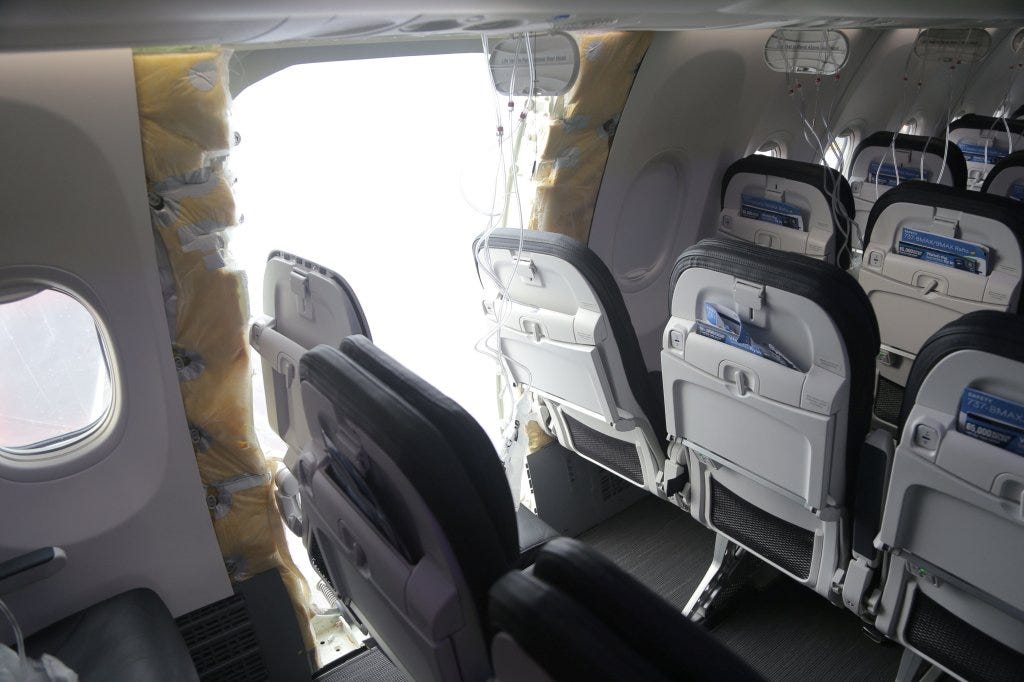
I’ll just bet you aren’t surprised to learn that the words “private equity” played a role in the door that an Alaska Airlines 737 Max 9 lost shortly after it took off from Portland International Airport. When you hear private equity, you hear rich guys, and when you hear them, you hear profits, and when you hear profits, you hear cost cutting, and when you start cutting costs in the manufacture of airplanes, they start falling out of the skies and losing doors, which is exactly what happened with the 737 Max 9 made by the Boeing Corporation.
The 737 Max 9 got itself back in the news with the loss of its so-called door plug early last month, and now it’s in the news again with a bunch of holes being found in new fuselages built by Spirit AeroSystems in Wichita, Kansas. But these recent, shall we say, unfortunate incidents come after the October 29, 2018 crash of Lion Air Flight 610, a 737 Max 8 in Indonesia, killing all 189 people on board 13 minutes after takeoff. Less than a year later, on March 10, 2019, another 737 Max 8, Ethiopian Airlines Flight 302, crashed six minutes after takeoff from Adis Ababa, killing 149 passengers and 8 crew members.
What’s going on with Boeing and its 737’s, of which there have been more flying in the skies than any other commercial aircraft ever made? Well, it’s no longer just a Boeing aircraft, for one. The Boeing Corporation sold its Spirit AeroSystems factory in Wichita that makes the 737 to a Canadian private equity firm, Onex, in 2005, for about $950 million, including a contract to continue producing fuselages for the 737 for Boeing. Just nine years later, Onex spun off Spirit as a public company. A report in GlobalNewswire at the time said that “Over the course of the nine-year investment, the Onex Group has received aggregate proceeds of approximately $3.2 billion, resulting in a multiple of capital invested of approximately 8.5 times and a return on investment of 201% per annum.”
Four years later, the first 737 Max 8 fell out of the sky.
You cannot draw a straight line between the sale by Boeing of its main manufacturer for its 737 fuselages and the cascade of accidents and defects that followed – you never can in these kinds of things – but it’s hard to miss the connection between money that went into a few people’s pockets and bodies that hit the ground in Africa and went into the ocean off Indonesia.
There have been dozens and dozens of accidents involving 737 commercial aircraft since the 1970’s, some of them famous. Remember the crash of Air Florida Flight 90 into the Potomac River moments after takeoff from National Airport in 1982? There was a huge snowstorm involved, and a bunch of pilot error, including failure to turn on engine de-icers and improper procedures on the runway prior to take off. They made a TV movie and a bunch of documentaries about that one.
Many of the other disasters involving the 737 were similar – planes overshooting runways, colliding with other aircraft, hijacked and exploded on runways, planes running into mountains in bad weather. Some crashes just happen – there have been unexplained crashes in Sudan, Afghanistan, Algeria, the Philippines over the years. But mostly it’s pilot error, weather, accidents caused by small planes colliding with 737’s.
But the recent situation with the 737 Max aircraft that fell out of the sky, and the door that flew off the Alaska Air flight are different. The two 737’s that crashed killing everyone on board both experienced flight control problems shortly after take off involving the planes’ MCAS, or Maneuvering Characteristics Augmentation System, a flight stabilizing system invented by Boeing that malfunctioned and aimed the planes straight for the ground and put them out of control of the pilots. It was a failure of an automated system intended to make the planes safer that ended up making them deadly.
That’s the thing about airplanes. When something goes wrong and you’re thousands of feet above the surface of the earth, it’s way, way different than something going wrong with your car like a blown tire or even a power steering system or brakes that fail. That’s why the proper design and manufacturing of airplanes is such a crucial thing, especially commercial aircraft that carry hundreds of people on each flight, and many tens of thousands of people every day in the skies all over the world. One little mistake, one little design flaw, and hundreds can die.
What went wrong with the Alaska Airlines door plug is a perfect example. The door plug is a piece of the fuselage that replaces a door that’s not installed because of a particular plan of the interior of the plane. When a plane is designed to carry fewer people, it needs one less emergency exit, so that space, which is built into the fuselage in the factory, is filled with a plug – a piece of fuselage that should have been bolted into place but wasn’t.
Spirit AeroSystems, now a public company with investors and a share price that is subject to the success of the company in selling fuselages to aircraft manufacturers like Boeing and Airbus, makes fuselages for 737’s in Wichita and sends them by rail to the Boeing plant outside Seattle, Washington, where they are manufactured into fully-functioning airplanes. The fuselages are shells, ready for the installation of everything else that makes them a commercial plane – the interiors consisting of insulation and wiring harnesses and the interior skin of the aircraft, the windows, floors, seats – in short, everything you see when you walk on board a flight.
The door plugs are usually fixed in place by Spirit so Boeing can remove them and use the large opening in the fuselage to load all the stuff that goes into the interior of the plane. Then they’re supposed to stick the door plug back onto the fuselage and bolt it into place.
This wasn’t done, either by Spirit in Wichita or by Boeing in Renton, Washington. Apparently, the situation with the holes in the fuselage of the 737’s is similar. They were either supposed to be drilled by Spirit and then fitted with rivets or bolts when windows were installed by Boeing, or they were drilled by mistake on fuselages for which they were not part of the specifications.
There are thousands of these specifications on aircraft like a 737, holes through which wires run, little plastic or rubber grommets fixed into the holes to keep the wires from fraying...the same with hydraulic lines that run the aircraft’s landing gear, and the fly-by-wire actuators that now power flaps and other control surfaces. Inside the plane, all that plastic you see above and next to your seat along the walls, it’s all screwed or bolted or riveted into place with little insulators that prevent it from squeaking and making a racket when the plane flexes in flight.
And this is not even to mention the plane’s engines, and the flight controls in the cockpit and all the wires and computers and chips and the blizzard of electronics that starts up an airplane and takes it off and keeps it in the air until the pilots land the thing.
All that stuff has to be built just so, or door plugs fly off planes, or worse still, planes nosedive into the ground or the ocean.
Because we live in a world where Capitalism is King, there is competition between aircraft manufacturers for the business of airlines, and competition between the airlines for the business of passengers, and of course competition between the people who work in the business of building aircraft and flying passengers from point A to point B to get promotions and better paying jobs, and some of that competition involves doing things faster and cheaper, all of which is intended to make more money.
There is a federal securities lawsuit against Spirit AeroSystems right now accusing the company of covering up quality control problems and “excessive amounts of defects” and firing employees who have complained about problems in the manufacturing process of the fuselages the company provides to Boeing.
Listen to this: Questioned by Jacobin Magazine about the lawsuit alleging major problems in manufacturing the fuselages it buys from Spirit, “a spokesperson for Boeing, declined to comment on the allegations raised in the lawsuit. ‘We defer to Spirit for any comment,’” the Boeing spokesman wrote in an email. Jacobin reported that Spirit AeroSystems “did not respond to multiple requests for comment on the federal lawsuit’s allegations.”
After the door plug flew out of the Alaska Airlines plane and landed in a woman’s backyard near Portland, the company issued this statement to the press: “At Spirit AeroSystems, our primary focus is the quality and product integrity of the aircraft structures we deliver.” They have had no comment on the federal securities lawsuit.
The federal lawsuit involves complaints by investors in Spirit AeroSystems. According to Jacobin, “The company has been under pressure from Boeing to ramp up production, and in earnings calls, Spirit’s shareholders have pressed the company’s executives about its production rates.” United Airlines undertook its own inspection of the 737 Max 9 planes in its inventory and found numerous loose bolts throughout its planes. One of the complaints by an employee in the lawsuit alleges that torque wrenches in workers’ toolboxes were found to be mis calibrated. According to the federal complaint, “This was potentially a serious problem, as a torque wrench that is out of calibration may not torque fasteners to the correct levels, resulting in over-tightening or under-tightening that could threaten the structural integrity of the parts in question.” The complaint alleges that 1,400 wrenches were found “out of alignment.”
This is what it boils down to. You put pressure on workers to hurry up and get this installed, and then run over and get that thing mounted and make sure another component is where it should be, and they’ve got to move from one location to another and re-adjust their torque wrenches differently for each task, and as they hurry up, they miss stuff, and bolts aren’t installed, or are tightened wrongly, or holes are drilled where they shouldn’t be, or the rivets that belong in the holes are missing around the windows.
You walk onto a plane as it is going through passenger loading on the ground, and you look around, and you don’t see the bolts behind the plastic skin on the walls and ceiling of the plane, you don’t see the missed rivet on the window, or the uninstalled bolt on the door plug at the end of the row of seats that you paid more money for, so you would get the extra legroom.
But somewhere, there’s an earnings call, and an investor is asking about production schedules, and Boeing is making its bid to supply an airline somewhere in the Middle East or Africa with another half-dozen 737 Max 9’s, trying to beat out Airbus, who is offering a really good price on its A320neo’s…
We invented this stuff – commercial airlines and the aircraft they fly, from DC-3’s to 707’s to 747’s to 737 Max 9’s, to whatever they’ve got in their CAD computers right now, designing the next iteration of how we will get from point A to point B crammed into hard seats praying that our extra legroom seats won’t unbolt from the floor when the doorplug at the end of Row 17 starts its long fall to some lady’s backyard.
This is the world we live in, where not only do we give them our money for tickets, we pray that they’ll spend at least some of it keeping us safe in the air.













Lucian, I’m a retired scientist from NIST—the National Institute of Standards and Technology—with 26 years of experience in metrology; i.e., the “Science of measurement.” Central to that is the calibration of gauges, instruments, and the traceability that is part of that process. Traceability is the contiguous line of measurements and documentation to prove that a given process or instrument is “within spec,” meaning that it will measure a certain quantity within specified limits.
Torque wrenches, for example, would be one of the most basic, obvious examples of that traceability process. It’s straightforward and doesn’t require any significant amount of science or technology to back it up. But, what it does require is the quality-control systems to ensure the instruments are always within specification. And if they’re not…well, door plug failures might be a good example of what can happen.
This is a perfect example of why “unfettered capitalism” and Trumpian cries to “Deconstruct the Administrative State!” are so threatening. Who else is going to do this stuff than boring government entities with no allegiance to any particular company? That is precisely NIST’s charter; the government organization 99% of the public has never heard of, in spite of the fact that NIST has at least five Nobel laureates on staff or emeritus. Celebrity culture never caught up with NIST, unfortunately.
Think about that the next time you board a flight. Who do you want responsible for the tools and measurement systems used to verify the integrity of the aircraft you’re on; a private-equity-funded corporation? Or objective, neutral government experts in measurement science and instrument calibration?
I believe it's private equity firms that are sucking up newspapers, firing journalists and other staff, making their quick profits, and then leaving the shell of the paper to rot. The "masters of the universe" need those profits so they can buy up more companies, strip them of their value, and take those profits to buy more companies and continue this cycle of greed. It'd be a pathetic pissing contest if it weren't for the death and destruction these people cause and leave in their wake.